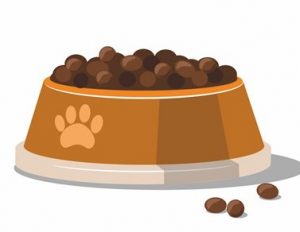 Give your senior dog the best food you can afford. Most people provide manufactured food for their dogs. The choices are infinite. One major caveat: avoid the cheapest brands, as, according to most reviews, the protein content is of very poor quality and the remaining content is often “filler” that may not be optimal for your dog’s health. Choosing a cheap food is likely to have a negative impact on your dog’s overall health and, in the end, any savings you derive will be spent on fees for veterinary visits.
Give your senior dog the best food you can afford. Most people provide manufactured food for their dogs. The choices are infinite. One major caveat: avoid the cheapest brands, as, according to most reviews, the protein content is of very poor quality and the remaining content is often “filler” that may not be optimal for your dog’s health. Choosing a cheap food is likely to have a negative impact on your dog’s overall health and, in the end, any savings you derive will be spent on fees for veterinary visits.
We’ve noticed that there is a range of advice that veterinarians give about the best commercial food for dogs — everything from widely available, aggressively advertised brands to freeze-dried raw and small-batch premium diets. We recently came across The Dog Food Adviser website. We think it's a good resource, as it's developed by a group of professionals, including veterinarians.
Home-prepared Food
You’ll find endless information on dog nutrition on the Internet. If you’re inclined toward preparing raw food or cooking for your dog, you can find recommendations for various types of home-prepared food. Recipes abound — from the BARF (Bones And Raw Food) diet to cooked.
There is, of course, nothing like fresh, unprocessed food when it comes to maintaining the good health of either humans or dogs. However, most people don’t have the luxury of enough time to prepare fresh food for their dogs’ meals, or haven’t found consistent information on how to do it, or just can’t deal with the inconvenience of shopping for and storing ingredients, and the other aspects of fresh food preparation. PetMD offers a comprehensive discussion on home-prepared diets that will help you decide if that's the direction you'll follow.
If you are inclined toward “natural” approaches to good health, you should review the information on how to prepare fresh food at Dr. Dobias’ site. The Balance It and PetDiet sites also provide recipe creation instructions. (A forthcoming revision on the Balance It site promises an easier interface for recipe creation; the company has not provided a date for the revision.) These three recipe-builder sites require that you purchase proprietary supplements to create the best nutrition program for your dog. Here’s additional information on supplements. Another option for home-prepared food, is to consult a veterinary nutritionist.
Raw Food Diets
Raw food diets have come into favor recently, and some are available in a freeze-dried form that is convenient and has been getting excellent reviews. Regarding raw food diets, the American College of Veterinary Nutrition has this to say:
“Raw diets, both home-prepared and commercial, have become more popular. Advocates of raw diets claim benefits ranging from improved longevity to superior oral or general health and even disease resolution (especially gastrointestinal disease). Often the benefits of providing natural enzymes and other substances that may be altered or destroyed by cooking are also cited. However, proof for these purported benefits is currently restricted to testimonials, and no published peer-reviewed studies exist to support claims made by raw diet advocates. No studies have examined differences in animals fed raw animal products to those fed any other type of diet (kibble, canned, or home cooked) with the exception of looking at the effects on digestibility. Typically raw meats (but not other uncooked foods like grains or starches) are slightly more digestible than cooked meat."
The best advice we can give you for finding the best nutrition program for your senior dog is: (1) discuss the topic with your veterinarian and spend some time the Dog Food Adviser site; (2) if you decide on dry food, add fresh foods on a regular basis; and (3) keep an eye on consumer alerts concerning product recalls.
What about variety?
Does a dog need variety in his meals? It seems to make a lot of sense, and many commercial brands offer it. Variety means a dog will be getting nutrients from different sources. Being observant about how your dog behaves around mealtime — his level of interest in the food, for example — along with his energy level, the sparkle in his eyes, and the appearance of his coat and skin — will tell you a lot about whether the food he’s eating is keeping him in optimum health.
How many meals per day?
The Senior Dogs Project has consistently given our adopted dogs two meals daily rather than one large meal. Lately, a question has been raised about whether this is optimum. In our view, a second meal presents another exciting event in our dogs' daily lives, giving them something to look forward to and enjoy. We also think (but can't conclusively prove) that two meals are better for an older dog’s digestion and to maintain energy throughout the day. More information is likely to be coming on the issue. In the meanwhile, evaluate carefully and introduce your dog to any new food or eating routine gradually to prevent gastrointestinal upsets.
